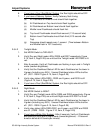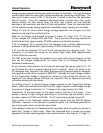
Airport Systems
SG-60 High Intensity Strobe System 3-2 Manual EPM-00000019 Rev A
energy storage capacitors discharge rapidly through the flashtube. The high discharge
current briefly heats the xenon gas to great temperatures, producing a bright flash. The
short-circuit output current of the T1 transformer is limited to less than the flashtube's
shut-off current. Once the capacitors discharge below a certain level, the current
flowing through the tube cannot keep the xenon gas ionized, and the flashtube
becomes a non-conductor and shuts off (self-extinguishes). Once the flashtube shuts
off, the selected energy storage capacitors immediately begin charging the next flash.
Relays K1 and K2 control which energy storage capacitors are charged, and thus
determine how bright the next flash will be.
When K1 and K2 are de-energized (as shown in Figure 3-2, Page 3-12), C1, C2, and
C3 are charged (C3 includes C3A and C3B). This is provides the energy required for
the Day Mode flash (approximately 270,000 candela (cd) effective intensity).
If K2 is energized, C3 is removed from the charging circuit, and the reduced energy
produces a Twilight Mode flash (approximately 20,000 cd effective intensity).
If K1 and K2 are energized, C2 and C3 are removed from the charging circuit. The
remaining C1 provides the energy for the pulsed Night Mode flash (approximately
2,000 cd effective intensity).
The DB1 diode block isolates the capacitors from each other during charging, so that
they can be charged independently, but allows them to all discharge through the
flashtube simultaneously.
As an automatic safety feature, the K3 relay will discharge the energy stored in C1, C2
and C3 when the case is opened (opening the S1 interlock). Never rely solely on the
K3 discharge relay, because if the safety discharge wiring became loose or damaged,
the capacitors could still be charged to 2000VDC. Although the High Voltage indicator
on the Trigger/High-Voltage is designed to indicate any high voltage still stored in the
capacitors, you should always discharge the capacitors with an approved grounding
rod before working with the system.
The 450Vp-p from T1 is used to charge a trigger capacitor on the Trigger/High-Voltage
Board. When the flashtube should be fired, this trigger capacitor is discharged through
the primary of trigger transformer T4. T4 steps up the trigger pulse to the 15KV
Transformer T2 provides power for the digital circuitry, and the K1-K3 relays. It can
accept a variety of input voltages depending on the primary tap connections, and it
provides outputs of 12VAC and 24VAC. The T2 inputs are protected by fuse F2.
Logic circuits in the Flashhead receive command signals from the SGC-60 Master
Controller. However, in the absence of command signals, the Flashhead generates its
own timing signal, which controls the rate of flash.
Test switches located on the Flashhead switch assembly allow the system to operate in
either Day, Twilight or Night mode. When the Flashhead door is closed, the system
operates in Remote mode regardless of the switch positions. See Figure 1-2, Page 1-3.


















